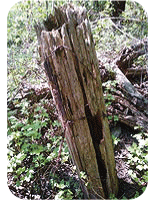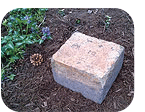Welcome to Four Point Learning
Principles of Boundary Law
 “When is a fence not a boundary?” The answer may be as simple as “When it is just a fence.” But assessing the significance of a fence is often a daunting exercise. Is the remnant of a fence (as in this picture of a cedar fence post with two strands of barbed wire) evidence of a boundary? Could it be evidence of the extent of possession? Answers to such seemingly simple questions can be elusive unless the context, origin, and legal importance of such evidence can be determined.
“When is a fence not a boundary?” The answer may be as simple as “When it is just a fence.” But assessing the significance of a fence is often a daunting exercise. Is the remnant of a fence (as in this picture of a cedar fence post with two strands of barbed wire) evidence of a boundary? Could it be evidence of the extent of possession? Answers to such seemingly simple questions can be elusive unless the context, origin, and legal importance of such evidence can be determined.Some might think that the preferred evidence of a boundary corner is a survey monument. Ideally, yes. Practically,
 such is seldom the case. Even when encountered, an original survey monument is evaluated in terms of original position and provenance. “When does a survey monument not mark a boundary?” In this picture, the answer is simply “When it is a garden ornament.”
such is seldom the case. Even when encountered, an original survey monument is evaluated in terms of original position and provenance. “When does a survey monument not mark a boundary?” In this picture, the answer is simply “When it is a garden ornament.”Unlike engineering or mathematics, a property retracement problem may not have a clear solution. The “mathematically correct” answer may be based on incomplete information that does not include the evaluation of all available evidence. Since every retracement survey has the potential of being reviewed by a court, adopting an approach that uses the same principles a court would apply in determining a boundary location, increases the likelihood that the surveyor’s work is “legally correct.” In this 5-min video:
an instructor for Four Point Learning uses Internet resources, interactive whiteboard and voice-over as integrated tools to explain an approach to writing a survey report that deals with evidence and boundary principles.
Another useful resource in the application of legal principles to facts established through evidence is:
This free monthly e-newsletter provides a review and commentary of current cases involving some issue or aspect of property title and boundary law. All issues can be accessed and searched. You can also subscribe to The Boundary Point by either completing the sign-up form if you do not have an account or editing your profile if you already do.
We welcome your support
for the TBP to remain free.
Current Issue: Strata Plans and Boundaries: A Decision Directing an Amendment to a Plan
Law Times Article: Call for clarity on Crown’s duty to consultSection 35 of the Constitution Act, 1982 recognizes and affirms aboriginal and treaty rights and, as the Supreme Court of Canada confirmed in Haida Nation v. British Columbia (Minister of Forests), involves a duty upon the government to consult Aboriginal peoples and, at times, accommodate their interests. Such a duty is grounded in the honour of the Crown. Since the adoption of the language in 1982, indigenous peoples, resource industries and governments across Canada have all sought clarity about what is meant by the Crown's duty to consult. This article speaks to the need for clearer direction.
Related Resource: Integrating Aboriginal Interests with Fee Simple
